The first worthwhile shot I took was of the Sun, on 7th. January 2001, with a Baader Solar film filter. Unretouched picture, but sunspots visible. Maximum zoom.
NOTE that 'full zoom' means full optical zoom only, 'maximum zoom'
means full optical plus digital zoom.
|
The first worthwhile shot I took was of the Sun, on 7th. January 2001, with a Baader Solar film filter. Unretouched picture, but sunspots visible. Maximum zoom. |
Lunar Eclipse 2001
|
The Lunar Eclipse on 9th. January promised to be an exciting spectacle, with several occultations of fairly bright stars. Unfortunately my part of the world was well clouded in. A brief glimpse of totality, not enough to photograph. But towards the end of the eclipse, the clouds started to thin, and I got a couple of shots through the clouds at maximum zoom. Pictures unretouched. |
|
This shot was taken afocally with my C8, using a 40 mm eyepiece, camera unzoomed. 1/100th sec. ISO 100, f2.8 (camera) Despite the thin cloud, there was enough detail here for slight unsharp masking to be applied. The Umbra is obvious, and the darker part of the Penumbra can also be seen. Picture timed at 2146 UST |
|
Nature always seems to take a perverse delight in confounding astronomers, and sure enough, the skies cleared completely after the eclipse ended. So I took a photograph of the Full Moon, also afocal with a 40 mm eyepiece, unzoomed. 1/800th sec. ISO 100, f3.2 (camera). I'm very pleased with it! Slight unsharp masking. The usual 'full size' image can be seen by clicking on the thumbnail, but the original 1600 x 1200 picture is also available here. Note: This photo was published in Astronomy Now, June 2001 |
A few days later on 14th. January, there was a nice gibbous Moon with good seeing. So a selection of shots are shown here. The close ups have been converted to grayscale to reduce the file size - there was not much colour in them anyway.
|
Camera alone, maximum zoom |
Afocal, 40 mm e/p, no zoom |
Afocal, 40 mm e/p, full zoom. |
Afocal, 40 mm e/p, max. zoom. |
Afocal, 40 mm e/p, max. zoom. |
|
A few constellations at first in a reasonably dark sky: The Plough (Big Dipper) in Ursa Major, and a rather light polluted Sickle in Leo. Both these pictures have had their backgrounds darkened in Photoshop. f 2.8, 16 secs., ISO 400. The lower section of Orion at maximum zoom was the next picture. f 2.8, 16 secs, ISO 100
|
|
A maximum zoom shot of the Pleiades came out very well, with good depth of star magnitudes. f 4.0, 16 secs., ISO 100. But a photo showing more detail taken through my 80 mm Short Tube Refractor is shown below. |
|
Once I'd fixed up the camera afocally with my C8, the Orion nebula was the first deep sky object to go for. There was a lot of moisture in the air this night, and consequently appalling sky glow from street light pollution. This unretouched photo shows just how bad. f 2.8, 16 secs., ISO100
|
|
The actual shot, unzoomed, afocal with 40 mm eyepiece shows huge light pollution, nevertheless the nebula is undoubtedly there! The circle is vignetting by the eyepiece, due to the large lens on the camera. Not really a problem in practice f 2.8, 16 secs., ISO 400 (This is the maximum exposure available) |
|
|
The main picture was 1600 x 1200 pixels, so the area round the nebula still has plenty of detail. And with as much of the orange removed as possible, the nebula shows up well. Wait for a really dark night! |
|
|
|
|
|
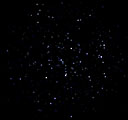 |
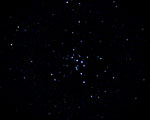 |
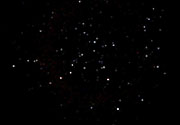 |
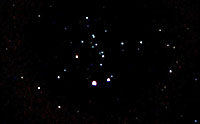 |
|
On 11th May 2001, I was at a local dark site (Derwent Reservoir - see light pollution pic) and had a go at M13. This is what I got, afocal with 40 mm eyepiece on LX90 8" SCT, 16 secs, ISO 400, dark frame subtracted and levels adjusted in Adobe Photoshop. In the original (adjusted) image, stars down to 13th. magnitude can be identified.
|
|
Scorpius was magnificent, with Mars as a focal point. The usual enlargements are available, and for a larger (1200 x 900) image with the constellation lines, click here (110 Kb). 16 secs. 38 mm focal length, f 2.8. Stars down to around 6th, occasionally 7th. magnitude approximate the best naked eye visibility. |
|
The region surrounding Crux, the Southern Cross, is awash with stars. These photos show the constellations, and the great Globular Cluster, Omega Centauri. Again, for an enlarged (167 Kb) constellation view, click here. |
|
Of all the clusters requiring a telescope, the Double Cluster in Perseus is probably the best known, and certainly one of the most beautiful. It's a bit big for the 2000 mm focal length of the 8" LX90 SCT, but with a 0.63 focal reducer installed, it fits nicely into the field of a 40 mm eyepiece. |
There are a number of large clusters, the Pleiades probably the best known, which are best viewed through either binoculars, or a telescope with a short focal length. My ST80 is well suited for these, and here is a selection. All photos were taken using the camera afocally with a 40 mm eyepiece, 16 seconds at ISO 400, unzoomed.
|
The Pleiades - the Seven Sisters in Taurus. Logged by Messier as M45. Nowadays with light pollution abounding, the seventh star is not so easily seen, but the cluster is a beautiful object in the 80 mm ST, nicely fitting into the wide field produced by the 400 mm focal length. A close up of the primary star, Alcyone and its spectacular grouping with three other stars can be seen on my deep sky page, click here. |
|
|
Another popular naked eye cluster is Praesepe - The Beehive, M44, in Cancer. Also best in the 80 mm ST. Not so easily seen in light polluted skies without optical aid. |
|
|
Less well known, and a difficult naked eye object in light polluted skies, is Brocchi's Cluster in Vulpecula. Also classified as Collinder 399, but best known, and obvious from its shape, as the Coathanger. A very striking binocular object, and again well suited for the 80 mm ST. This image appeared in the July-September 2008 issue of the SPA magazine. |
|
On 11th. October 2001, our local Astronomical Society had a viewing session on the coast at South Shields. A bit windy and some cloud, so many people packed up after an hour or so. But I was one of the last to leave, and just before going noticed that a faint glow over the sea to the North, which we had assumed to be a sunset afterglow, had developed into an Aurora! Not particularly impressive, but my first! So out with the camera, and before the brief show ended, I captured a few shots, of which this is the best. The Aurora itself is the green vertical bands, reflected in the sea. The orange line across the middle is a wall illuminated by street lamps a few hundred yards away, and the orange colour in the sky is clouds lit from below by light pollution. |
|
The end of April 2002 was graced by a stunning line up of the five bright planets in the evening sky. Unfortunately the weather as usual played up and hid the straight line behind clouds, but relented on a couple of evenings giving very clear air, albeit cold and windy. So here are two views, one looking across the River Tyne (26th. April), one beside the Angel of the North (29th. April). The changing positions of the planets can be clearly seen. Thank goodness the weather was reasonably kind for once. I don't think I'll be around in 58 years' time! |
|
Whilst on a skiing holiday in the French Alps in January (2003) I woke up early one morning (19th. Jan.) and looked out of the window to check on the weather. And there at the head of the valley was Venus, blazing glorious in the pre-dawn light! The snow clad mountains and valley floor were still lit by the soon to set but almost full Moon, and this picture was the result. 16 second exposure, 38 mm equivalent focal length, f 4. (Published in the May 2003 issue of Astronomy Now) |
|
The previous night I also photographed the constellation of Orion, standing nicely in the South above the moonlit snow covered ridge of the Samoëns Ski Resort. The highest point on the ridge is around 2100 metres, the air was crisp and clear, and a star can be seen almost touching the snow! Settings 16 seconds, f2.8, 38 mm fl. The star magnitudes are approximately good naked eye i.e. around 6. Click on the thumbnail for a larger (58KB) image. A larger (290KB) image is available here. This image appeared on the BBC Sky at Night TV programme in February 2011, and again in August 2012. |
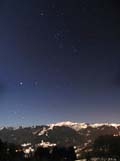 |
|
Here is a version with Constellation lines and Star names. Click on the thumbnail for a larger (164KB) version |
|
In the Spring of 2003 Jupiter closely approached M44 - the Beehive Cluster - but before crossing it, retrograde motion took the planet away again. Here's a shot I took at 2135 UST on April 4th. Native lens at full zoom (10x = 380 mm equivalent), 16 second exposure, ISO 400, f3.5 (full aperture is f2.8, f 3.5 chosen to give the pretty diffraction spikes instead of an overexposed blob!). The upper picture is the full frame, the lower is the centre section cropped out. Stars down to 10th. magnitude. The 'star' close to Jupiter at 8-o-clock is in fact the Galilean moon Callisto. |
For some more images with Olympus Cameras, have a look at the following links:
Gary Honis and a Japanese site